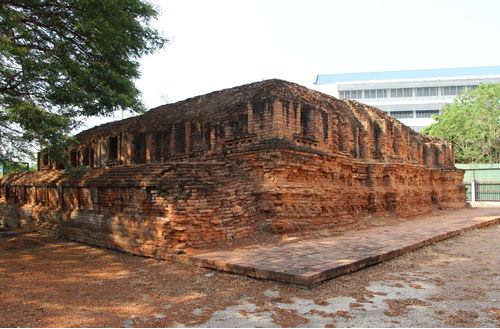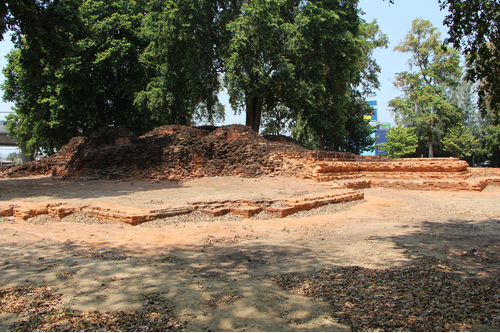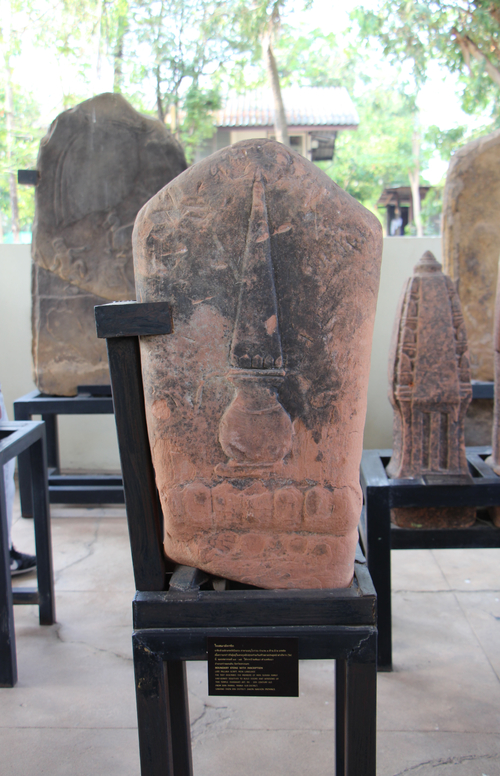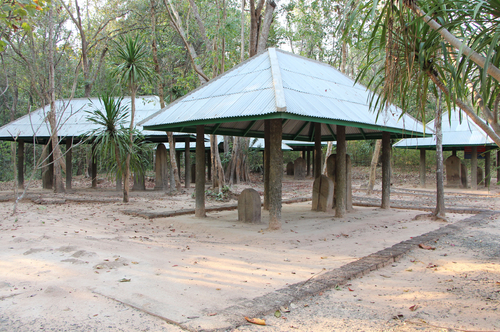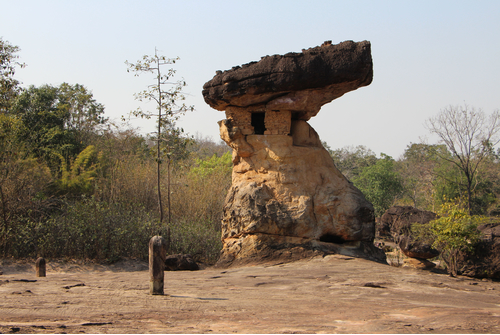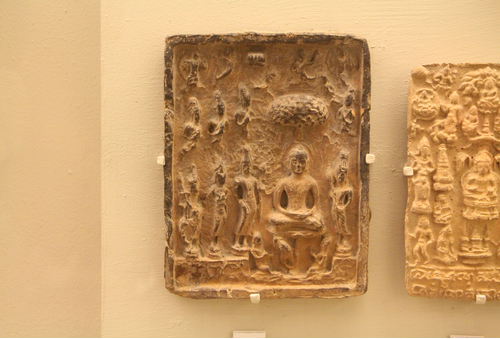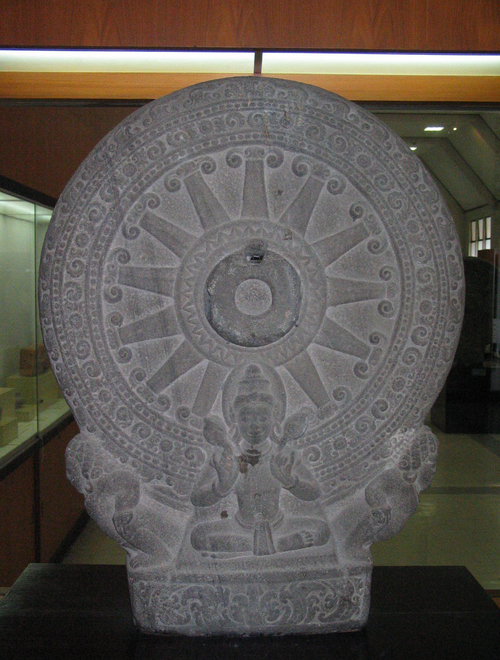ค้นหางานศิลปกรรม
ฐานข้อมูลศิลปกรรมในเอเชียตะวันออกเฉียงใต้
สถาปัตยกรรมเจดีย์จุลประโทน
เจดีย์จุลประโทนสร้างขึ้นจากอิฐ ได้รับการบูรณปฏิสังขรณ์มาแล้ว 1-2 ครั้งในอดีต สภาพปัจจุบันเหลือเพียงส่วนฐานและเรือนธาตุทึบตัน ส่วนยอดหักพังจนไม่เหลือร่องรอยแผนผังของฐานล่างสุดเป็นผังสี่เหลี่ยม ประดับด้วยเสาคั่นเป็นระยะ ระหว่างเสาแต่ละต้นประดับภาพปูนปั้นและดินเผาเล่าเรื่องชาดกในพุทธศาสนาและรูปอื่นๆ ปัจจุบันเคลื่อนย้ายไปยังพิพิธภัณฑสถานแห่งชาติ พระปฐมเจดีย์ แล้ว กึ่งกลางของแต่ละด้านเป็นบันไดขึ้นสู่ลานประทักษิณ ทั้งนี้ฐานส่วนนี้ปัจจุบันจมอยู่ใต้ดินองค์ประกอบชั้นถัดมาเดิมทีเคยอยู่ในผังสี่เหลี่ยมยกเก็จที่กลางด้านและที่มุม อันเป็นระเบียบทั่วไปของเจดีย์ทวารวดี แต่ต่อมาถูกก่อทับโดยฐานสี่เหลี่ยมที่ประดับด้วยบัววลัยหรือกลศและเสาคั่นเป็นระยะ ทำให้เกิดพื้นที่สี่เหลี่ยมระหว่างเสา ปัจจุบันฐานสี่เหลี่ยมนี้ปรักหักพังลงทำให้บางด้านสามารถมองเห็นฐานยกเก็จที่ซ้อนอยู่ภายในได้ ถัดขึ้นไปเป็นเรือนธาตุทึบตัน ประกอบด้วยซุ้มจระนำประดิษฐานพระพุทธรูปเรียงรายโดยรอบ พระพุทธรูปได้รับการเคลื่อนย้ายไปยังพิพิธภัณฑสถานแห่งชาติ พระปฐมเจดีย์ แล้ว ถัดขึ้นไปไม่ทราบว่าเป็นอย่างไร แต่ ศาสตราจารย์ ปิแอร์ ดูปองส์ สันนิษฐานว่าอาจซ้อนชั้นขึ้นไปเช่นเดียวกันกับเจดีย์กู่กุด อำเภอเมือง จังหวัดลำพูน
สถาปัตยกรรมวัดพระเมรุ
สภาปัจจุบันปรักหักพังเหลือแต่ฐานที่ผ่านการบูรณปฏิสังขรณ์แล้ว ไม่ทราบว่าส่วนยอดมีลักษณะเช่นใด แผนผังของวัดพระเมรุเป็นอาคารสี่เหลี่ยมที่มีการยกเก็จกลางด้านและมุม แต่ละเก็จมีบันไดทางขึ้น ตรงกลางเหลือเพียงแกนอิฐสี่เหลี่ยมที่ทำหน้าที่รับน้ำหนักส่วนยอด ด้านทั้งสี่ของแกนอิฐเคยเป็นที่ประดิษฐานพระพุทธรูปนั่งห้อยพระบาทด้านละ 1 องค์ มีทางเดินเวียนประทักษิณโดยรอบแกนอิฐและพระพุทธรูปเหล่านี้
ประติมากรรมใบเสมา
ใบเสมาแผ่นแบน ทั้ง 2 ด้านมีภาพสลักปรากฏอยู่ ด้านแรกทำรูปหม้อต่อด้วยกรวยอยู่ตรงกลางและกลีบบัวประดับอยู่ตอนล่าง ด้านที่สองทำรูปแท่นสี่เหลี่ยมต่อด้วยทรงกรวยอยู่ตรงกลางและกลีบบัวประดับอยู่ตอนล่าง ใกล้ๆกับรูปทรงกรวยมีข้อความจารึก รูปที่สลักอยู่ตรงกลางของด้านทั้งสองมีความเห็นจากนักวิชาการเป็น 2 ทาง คือ บางท่านสันนิษฐานว่าเป็นรูปสถูป ขณะที่บางท่านสันนิษฐานว่าเป็นรูปเครื่องบวงสรวงทำนองบายศรี
ประติมากรรมใบเสมา
ใบเสมากลุ่มนี้มีจำนวนทั้งสิ้น 24 ใบ ทุกใบอยู่ในทรงแผ่นแบน ปักตรงตามแนวทิศทั้งแปด ทิศละ 3 ชั้น ล้อมรอบพื้นที่สี่เหลี่ยม ความสูงของใบเสมาแต่ละชั้นไม่เท่ากัน ใบเสมาชั้นในสูงที่สุดจากนั้นค่อยๆ ไล่ลำดับความสูงลงมายังชั้นกลางและชั้นนอก ใบเสมาชั้นในกับชั้นนอกตั้งอยู่เคียงกันในขณะที่ชั้นนอกอยู่ห่างออกไปหลายเมตร ด้านในของใบเสมาชั้นในสลักภาพเล่าเรื่องที่บริเวณโคน สันนิษฐานว่าเป็นชาดก ในขณะที่ใบเสมาชั้นกลางและชั้นนอกสลักรูปกรวยเป็นส่วนใหญ่
สถาปัตยกรรมหอนางอุสา
โขดหินรูปร่างประหลาดที่เรียกกันในปัจจุบันว่า หอนางอุสา มีลักษณะเป็นแท่งเสาหินธรรมชาติที่มีหินก้อนใหญ่อีกก้อนหนึ่งวางทับอยู่ด้านบน กลายเป็นเพิงสำหรับพักอาศัยหรือประกอบกิจกรรมต่างๆ ได้ มีการกั้นผนังด้วยก้อนหิน ทำให้เพิงหินมีสภาพกลายเป็นห้องรูปลักษณ์ของหอนางอุสาเกิดขึ้นจากปรากฏการณ์ตามธรรมชาติ ในอดีตกาลหลายล้านปีมาแล้วชั้นหินบริเวณนี้ยังอ่อนอยู่ทำให้เกิดการกัดเซาะหรือชะด้วยน้ำและลม ส่วนใดที่อ่อนตัวมากก็ถูกกัดเซาะหรือชะจนหายไป ส่วนใดที่แข็งแรงทนทานก็จะยังคงตัวอยู่ได้ จากรูปร่างของหอนางอุสาอธิบายได้ว่า แท่งเสาหินและก้อนหินที่ค้างอยู่ด้านบนเป็นชั้นหินที่แข็งแรงทนทานต่อการกัดเซาะ ชั้นหินที่เคยอยู่ตรงกลางระหว่างหินทั้งสองส่วนอ่อนตัวกว่าจึงง่ายต่อการกัดเซาะ ในที่สุดจึงถูกกัดเซาะหายไป ทำให้หินชั้นบนกลายเป็นก้อนหินใหญ่ที่วางตั้งอยู่ในหินชั้นล่างที่กลายสภาพเป็นแท่งเสา รอบๆ หอนางอุสาเป็นลานหินขนาดใหญ่ มีหลักหิน-ใบเสมาปักบนลานหินเพื่อล้อมรอบหอนางอุสา
ประติมากรรมพระพิมพ์
พระพิมพ์ทรงสี่เหลี่ยมผืนผ้ามีภาพบุคคลจำนวนมาก พระพุทธเจ้านั่งทำปางสมาธิอยู่ใต้ต้นไม้ เบื้องล่างปรากฏบุคคล 2 คนซึ่งสันนิษฐานว่าอาจเป็นพญานาคนันทะกับอุปนันทะกำลังชูดอกบัวให้พระพุทธองค์นั่งทำสมาธิอยู่บนนั้น เบื้องซ้ายของพระพุทธเจ้าปรากฏภาพบุคคล 1 คน ในขณะที่ด้านขวาปรากฏภาพบุคคล 3 คน ถัดขึ้นไปในตำแหน่งที่ตรงกับบุคคลทั้งสองข้างก็ปรากฏรูปบุคคลเช่นกัน นับรวมรูปบุคคลได้ทั้งหมด 8 คน เหล่านี้น่าจะได้แก่เทวดาที่ลงมาเฝ้าชมเหตุการณ์ ที่มุมด้านบนทั้งสองข้างปรากฏภาพวงกลมมุมละ 1 วง ภายในมีรูปบุคคลปรากฏอยู่ เชื่อได้ว่าหมายถึงพระอาทิตย์และพระจันทร์ ถัดเข้ามาจากพระอาทิตย์พระจันทร์เป็นภาพเทวดาเหาะ
ประติมากรรมธรรมจักร
ธรรมจักรวงกลมประกอบด้วยส่วนสำคัญ 3 ส่วน คือ ดุมอยู่ตรงกลาง มีรูเจาะทะลุที่เหนือดุม ซี่หรือกำ ระหว่างซี่แต่ละซี่ไม่เจาะทะลุทำให้ธรรมจักรองค์นี้แลดูทึบ นอกสุดเป็นกงตกแต่งด้วยลายก้านขด ขอบกงเป็นลายเปลวเพลิง เบื้องล่างสลักรูปบุคคลนั่งขัดสมาธิและถือดอกบัว สันนิษฐานว่าเป็นรูปพระสุริยเทพ ด้านข้างมีรูปคนแคระแบกธรรมจักร ถัดลงไปเบื้องล่างเป็นฐานหน้ากระดานประดับลายกนก
ประติมากรรมพระพุทธรูปปางสมาธิ
พระพุทธรูปอยู่ในอิริยาบถนั่งขัดสมาธิราบแบบแปลกๆ พระหัตถ์ทำปางสมาธิ ใช้ประดับศาสนสถานดังนั้นด้านหลังจึงตัดเรียบพระพักตร์เหลี่ยม พระขนงต่อกันเป็นปีกกา พระเนตรเหลือบต่ำแสดงความสงบ พระนาสิกใหญ่ พระโอษฐ์แบะ ขมวดพระเกศาเวียนเป็นวงก้นหอย พระอุษณีษะนูนสูงเด่น ยอดสุดเป็นพระรัศมีแบบลูกแก้วพระพุทธรูปครองจีวรห่มเฉียง ไม่มีริ้ว บางแนบพระวรกาย แลเห็นขอบสบงบริเวณบั้นพระองค์ชัดเจน ชายจีวรหรือชายสังฆาฏิซ้อนทบกันพาดผ่านเหนือพระอังสาซ้ายพระหัตถ์ทำปางสมาธิ พระเพลาสลักให้เห็นเป็นมุมมองจากด้านบนจนแลดูคล้ายกำลังนั่งแบบตั้งพระชานุ ถือเป็นมุมมองที่แปลก มีชายจีวรพาดผ่านตรงกลางผิดทับข้อพระบาท เมื่อมองจากทางด้านข้างจะพบว่าพระเพลาอยู่ในแนวเดียวกันกับพระอุระและพระอุทร ไม่ได้ยื่นพ้นออกมาทางด้านหน้า ทำให้พระเพลามีกายวิภาคผิดไปจากความเป็นจริง
